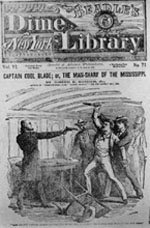 The
Riverboat Life
The
Riverboat Life
By the late nineteenth century steamboats had been traveling the Mississippi
for more than sixty years. They were as common to people then as
jets are to us today. Rivers like the Mississippi had long been important
means of transporting goods and people, but with the establishment of steam
power, they became the central way around America. Operating a steamboat
was a competitive business. During the height of steamboat use, there
were more than a thousand plying the waters of the Mississippi. Early
on, living conditions on board most boats was spartan for crew and passengers
alike. Ports often had a bustling, rough and tumble environment.
Along the Mississippi places like East St. Louis became crowded with travelers
and during the nineteenth century, many of the people who worked and traveled
on steamboats were slaves. The presence of slaves in such an unregulated,
busy and open environment often resulted in conflicts. Stretching
from the Gulf of Mexico to Canada, the Mississippi was a popular route
for fugitive slaves.
Over time engineers and riverboat captains improved steamboats.
Engines became much more powerful than that of the New Orleans,
the first steamboat to travel the length of the Ohio and the Mississippi
Rivers. Boats grew in size and luxury. Steam power continued
to be used into the twentieth century. Oil and coal replaced wood
for fuel and later diesel engines would replace steam. Before diesel
engines however, steam boat life changed very little even as steam boat
technology improved.
The Steamboat Life
More than simple transportation, pleasure steamboats offered a traveler
every accommodation. A trip on a fancy steamer was an adventure in
itself. Passengers in First Class enjoyed luxurious rooms and fine
dining. A few boats offered entertainment in their grand ballrooms
and a very few offered gambling - a feature that contributed to the popular
image of steamboats as fancy and daring places to be. Travelers not
in first class fared much worse, with cramped quarters and few amenities.
Along with luxurious accouterments, steamboats acquired powerful engines
and with them competition developed among various crews to see which boats
were the fastest.
 |
| Beadle's Half Dime Library Cover from July 24, 1879. |
A Steamboat Race
The most famous race began on June 30, 1870 in New Orleans, Louisiana.
Two of the most famous and fancy steam boats, the Rob't E. Lee and
the Natchez prepared to race from New Orleans to St. Louis, Missouri.
Thousands of people gathered to watch the race. It was a tremendous
event. People throughout the United States and Europe anticipated the outcome.
Thousands of dollars changed hands on various bets ranging from guessing
arrival times to which boat would win.
 The
Riverboat Life
The
Riverboat Life The
Riverboat Life
The
Riverboat Life